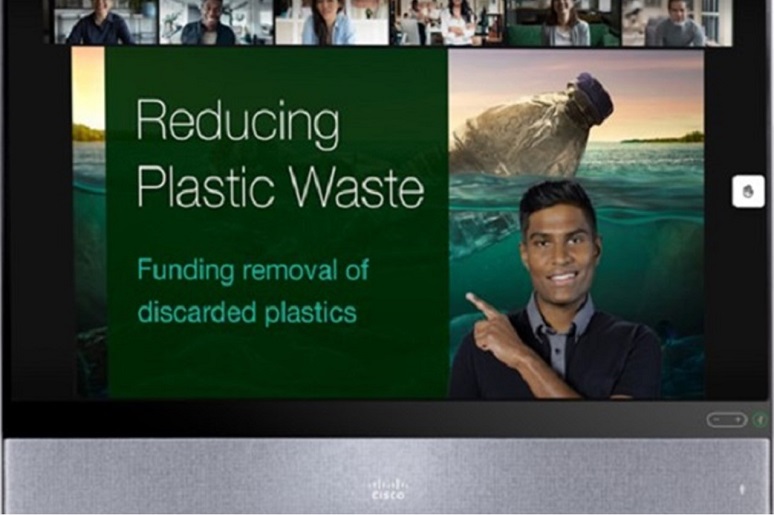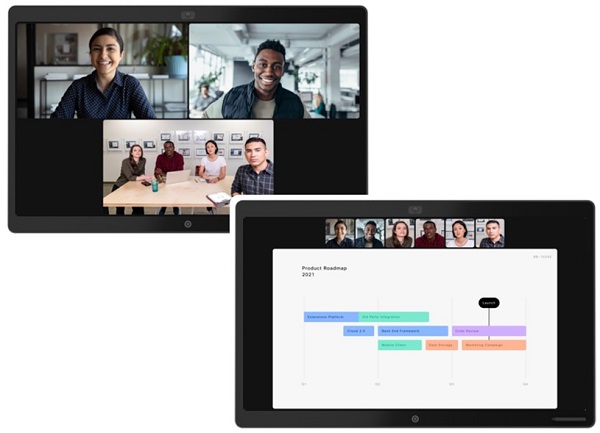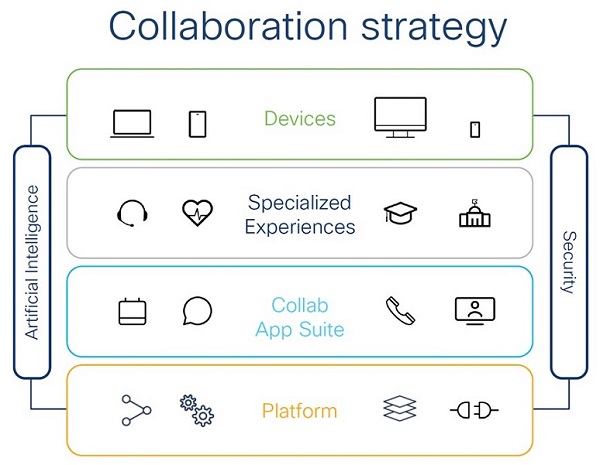Cisco, as demonstrated last week at Cisco Live, has put its
stake in the ground in a few areas — video meetings, hybrid work, platform integration/embedded communications, frontline communications, the desktop, and the contact center —that will define our industry in the next few years. Let’s explore.
Video Is Everything
“Yes Bob, I can see you.” “No Bob, I do not want to see you anymore.” The reality of COVID is that we have all become actors on the video stage; we know its values and downsides and have learned what’s important during a video call and what’s not. Video has become mainstream for many business use cases.
The result is a realization that simple videoconferencing can be woefully lacking, from its failure to address fatigue to its inability to balance people and content, and beyond. As we move forward into the post-COVID world, basic Hollywood Squares video and sharing will not be acceptable, nor do they provide any differentiation. The new video battleground is around improving the user experience and boosting engagement, with the help of AI-fueled features and functionality. Examples include
together mode for Microsoft Teams, introduced last summer, and
immersive share for Webex (shown above), introduced late last year and showcased at Cisco Live.
It is becoming clear that virtual meeting platform providers can use AI and video processing to create new and enhanced experiences. Implementing the engaging video processing we’ve seen in broadcast TV, but engaging AI systems to provide the control mechanism instead of a producer or editor, can be transformational for video meetings. I expect we will see all the major vendors come out with many exciting new capabilities, but this will prove challenging for the numerous smaller players in the video industry. As the large vendors continue to up the game in video processing, AI, and enhanced experiences, the smaller industry vendors will need to decide either to focus on areas where those capabilities are not critical or to invest to compete. As many of these video processing capabilities require advanced media AI processing, they require significant investment or acquisitions to achieve.
Back to the Office, or Not
At Cisco Live, Cisco addressed a top challenge in the IT community today: what to do when some employees return to physical offices while others remain working remotely. As I have noted previously on No Jitter, most surveys show 60-80% of employees do not want to go back to the old normal, and almost half would prefer a hybrid (or blended) work life.
While realtors and landlords must worry about reduced office space demand, IT must address what the changes in workspaces means. One major issue in the extensive use of videoconferencing is the two-edged sword of being visible. With visibility comes constant engagement, with none of the respite that comes when someone else is holding the stage. One of the values of video is being able to see everyone or anyone in the meeting when you want. As employees return to conference rooms, the ability of remote participants to engage is now very different. Cisco looks to address this with a people focus mode that allows remote participants to see individual video images of room attendees rather than a generic room view. The result is an experience that mimics the “all work from home” environment we have been living in the past year.
Enhancing the hybrid/blended experience, both for in-room and remote participants, will be another focus for vendors going forward. As Cisco emphasized at last week’s event, it believes that its ability to combine the core cloud platform and advanced edge hardware (cameras, room systems, all-in-ones, etc.) will enable it to deliver unique experiences. Microsoft and Zoom, to some extent, argue that they can leverage the innovation of multiple hardware vendors to deliver an optimal experience. In either case, obtaining and integrating the video processing, hardware, AI, back-ends, etc. into an effective solution is a challenge. Cisco has both the platform and the hardware and Microsoft and Zoom have a large enough installed base to entice the hardware vendors, but smaller players may be significantly challenged to duplicate these capabilities.
Platforms and Frontline Communication
Cisco, Microsoft, and Zoom all see their solutions as a platform to build communications into business processes. For example, see the architecture slide below for Cisco’s view of a platform that includes a range of capabilities for enabling integration into business processes.
For Cisco and Microsoft, the focus for platform architecture and integration is on extending beyond knowledge workers to frontline workers who follow a formal business process. For these workers, integrating communications, collaboration, and teams into the business process applications can be transformational and lead to major profitability. We can expect to see a major competitive battle for frontline communications between general-purpose platform providers like Cisco and Microsoft and embedded solutions providers like Twilio, Vidyo, and Kandy that offer embedded solutions that are ideal for users who only use the app to integrate to their companies and do not need interactions with knowledge workers. Amazon, while not a major player in the general collaboration market with Chime for virtual meetings and Connect for contact center, is increasingly positioning those as part of overall business process solutions — a strategy focused to the frontline worker. A focus on the frontline and embedded solutions may also be a path to relevance for some of the smaller vendors in the future. Delivering a solution for a large frontline workforce does not require the broad generic capabilities for the knowledge worker cadre.
What’s on your desk?
It is 2021, and Cisco wants you to have a Webex device on your desk. As such, it offers two sizes of large screen devices, a smaller device for mobile integration, and a new desk camera. Similarly, many Microsoft Teams partners offer Teams-certified desktop devices, and Amazon and Google assistant solutions have screen devices that include support for Zoom.
For most of the communications age, from the earliest Centrex systems to the latest VoIP, the telecom vendors have had a position on the desktop with a hardware device. This has not only been profitable, but it maintains relevancy and a place to deliver enhanced value. In the modern video collaboration world, this dedicated communications hardware may no longer be required. For effective group video and sharing, remote knowledge workers require two screens at a minimum: one for sharing, and one for people (just like the two-monitor conference rooms). Cisco argues there is a real need for a dedicated communications/video device that stays in the space (whether dedicated/shared office or home office) and is always there and ready. Such devices can also allow a business to incorporate additional capabilities.
The unknown is whether a modern PC/Mac with two monitors is a better option for most users than buying a dedicated device. For workers who are fixed (always or never in the office), a PC/Mac with two monitors can provide a similar experience to either a meeting room or the dedicated personal devices, but the user loses features such as one-touch joins and easy whiteboarding. Also, a number of the AI-based features rely on endpoint video processing and the capabilities of built-in AI processing provided in specialized hardware. Cisco is offering these capabilities in a USB camera peripheral to address this use case. The counter argument is that a dedicated communications device loses much value when the user is not in a meeting, while dual monitors on the PC/Mac can be useful all the time. Also, dedicated devices like the Cisco Desk Pro are relatively expensive when compared to traditional PCs and Macs.
As we plan for hybrid work environments, users and organizations will need to understand their needs and budgets to acquire and use these tools.
Contact Center — Only Part of the CX Solution
As Cisco talked about its new focus beyond the contact center into the realm of customer experience, it reinforced the fact that the contact center is rapidly changing. Customers demand myriad ways to connect and interact with brands, from phone calls, to text messaging, email, the web, social media, and beyond. With its
IMImobile acquisition now complete, Cisco has the capabilities to push beyond traditional phone-based contact center platform to deliver customer experiences and journeys across multiple channels.
Cisco has clearly decided that the contact center is going to come together with a range of other points to provide a managed customer journey and experience. While this is a logical and reasonable strategy, it will begin to bring the communications vendors into conflict with other customer experience vendors like Salesforce and Amazon. As the overall customer experience moves outside of the telephone and human interactions into the web, AI, and new business models, the contact center vendors will need to drive differentiated value.
Conclusions
We have reached the cloud, and the cloud is good. One of the benefits of moving to the cloud is the ability to add features and capabilities at cloud speed. Moving from 40-year-old PSTN code to modern container-based architectures dramatically reduces development and testing time and can include and integrate a range of capabilities. Add to that the combination of integrated edge and cloud processing, and you have a platform for dramatic change. We are seeing that in the explosion of innovation. The pandemic has driven adoption, adoption has driven new revenue in subscriptions, and that, in turn, is driving spending on innovation to differentiate and grow.












